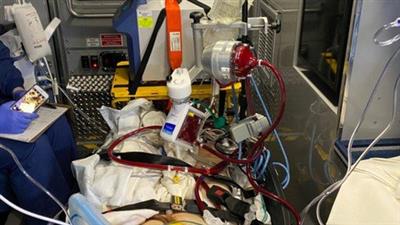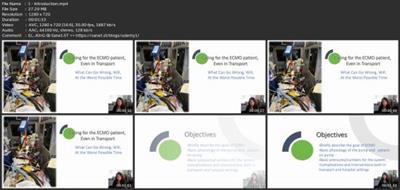Ecmo : In Hospital And Transport
Last updated 9/2022
MP4 | Video: h264, 1280x720 | Audio: AAC, 44.1 KHz
Language: English | Size: 1.36 GB | Duration: 1h 40m
What can go wrong, will, at the worse possible time
What you'll learn
Define ECMO and understand the purpose
Understand the separate circulation physiology between the patient and mechanical unit
Understand the most common emergencies with an ECMO patient
Understand interventions for the most common emergencies
Requirements
Critical Care Nursing, paramedics, respiratory therapy, perfusionists, transport technicians
Description
This course walks the student through the basic physiology of the ECMO system. In addition, it teaches about the most common emergencies and how to intervene with limited resources, especially in transport. Students that would benefit from this course in any critical care nurse, paramedic, or physician. Extracorporeal membrane oxygenation (ECMO), a term used to describe oxygenation that occurs outside of the body, is an increasingly common means of supporting the most critically ill patients. Because of the invasiveness and high probability of serious complications during ECMO, it is typically indicated only when there is a high likelihood of death with conventional treatment. With continued improvements in technology and increasing clinical experience, transport clinicians are increasingly likely to be called on to care for ECMO patients.*Highlights include: Critical care transport clinicians must appreciate the differences between venovenous and venoarterial extracorporeal membrane oxygenation (ECMO) as well as common indications for each and the physiology of both configurationsTraditional monitoring techniques such as peripheral capillary oxygen saturation may not be reliablePreparation for emergencies is imperative because decompensation can be rapid and masked until death occursECMO is a bridge to another option and is not a cureCritical Care Providers must know if a patient is a candidate for ECMO support prior to making the decision
Overview
Section 1: Introduction
Lecture 1 Introduction
Lecture 2 Objectives
Lecture 3 WHAT IS ECMO
Lecture 4 WHY VA ECMO
Lecture 5 ACCESS SITES/LINES
Lecture 6 Different Types
Lecture 7 Transport Specifics
Lecture 8 Pump Physiogy
Lecture 9 Patient Physiology
Lecture 10 Lecture 10 with Quiz
Section 2: Emergencies and Complications
Lecture 11 Bleeding
Lecture 12 Blood Pressure Management
Lecture 13 Loss of Flow
Lecture 14 Hypotension
Lecture 15 Oxygenation Part 1
Lecture 16 Oxygenation Part 2
Lecture 17 Oxygenation Part 3
Lecture 18 Lecture with Quiz #2
Lecture 19 Recirculation
Lecture 20 Differential Hypoxia
Lecture 21 Loss of Pulsatility
Lecture 22 End Tidal
Lecture 23 Air Embolism
Lecture 24 Pump Failure
Lecture 25 Hypothermia
Lecture 26 Circuit Rupture
Lecture 27 Decannulation
Section 3: Closing and Summary
Lecture 28 Brief Closing
Intermediate critical care nurses, paramedics, transport technicians, resident doctors, respiratory therapists
Download link
rapidgator.net:
uploadgig.com:Kod:https://rapidgator.net/file/9440cc94b17564a928390549f2c72547/mdrmz.Ecmo..In.Hospital.And.Transport.part1.rar.html https://rapidgator.net/file/d10c9e97aa4c91e087c93471055d2ebc/mdrmz.Ecmo..In.Hospital.And.Transport.part2.rar.html
nitroflare.com:Kod:https://uploadgig.com/file/download/c87fbf79df930287/mdrmz.Ecmo..In.Hospital.And.Transport.part1.rar https://uploadgig.com/file/download/B267fF0087a83536/mdrmz.Ecmo..In.Hospital.And.Transport.part2.rar
1dl.net:Kod:https://nitroflare.com/view/7B0E381B6EBB592/mdrmz.Ecmo..In.Hospital.And.Transport.part1.rar https://nitroflare.com/view/DEC42914425EC1B/mdrmz.Ecmo..In.Hospital.And.Transport.part2.rar
Kod:https://1dl.net/532ipqxp1mwj/mdrmz.Ecmo..In.Hospital.And.Transport.part1.rar.html https://1dl.net/t6e9elut4wjo/mdrmz.Ecmo..In.Hospital.And.Transport.part2.rar.html
2 sonuçtan 1 ile 2 arası
-
05.10.2022 #1Üye



- Üyelik tarihi
- 20.08.2016
- Mesajlar
- 143.644
- Konular
- 0
- Bölümü
- Bilgisayar
- Cinsiyet
- Kadın
- Tecrübe Puanı
- 152
Ecmo : In Hospital And Transport
-
05.10.2022 #2Üye



- Üyelik tarihi
- 24.02.2022
- Yaş
- 41
- Mesajlar
- 19.748
- Konular
- 0
- Bölümü
- Matematik
- Cinsiyet
- Erkek
- Tecrübe Puanı
- 22
Cevap: Ecmo : In Hospital And Transport
[Misafirler Kayıt Olmadan Link Göremezler Lütfen Kayıt İçin Tıklayın ! ] Mua sắm an toÃ*n vÃ* tiá»n lợi vá»i hình thức giao hÃ*ng nháº*n tiá»n của chúng tôi. Má»i thứ bạn cần Äược ÄÆ°a Äến báº*c cá»*a nhÃ* bạn chá» sau 1 cú nhấp chuá»t
Tá»ng ÄÃ*i 8217687852
Konu Bilgileri
Users Browsing this Thread
Şu an 1 kullanıcı var. (0 üye ve 1 konuk)



 LinkBack URL
LinkBack URL About LinkBacks
About LinkBacks






 Alıntı
Alıntı
Konuyu Favori Sayfanıza Ekleyin